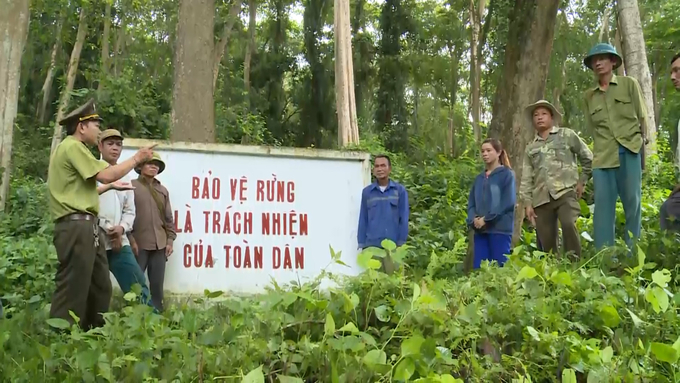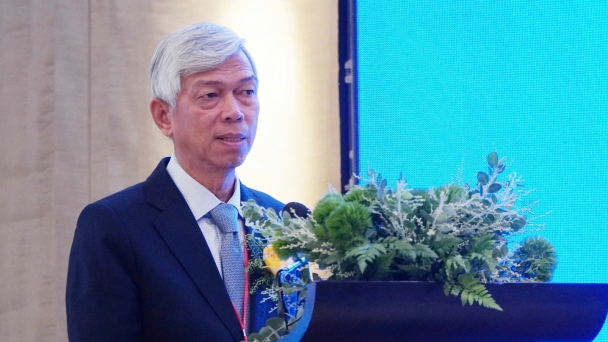December 19, 2024 | 17:20 GMT +7
December 19, 2024 | 17:20 GMT +7
Hotline: 0913.378.918
December 19, 2024 | 17:20 GMT +7
Hotline: 0913.378.918

The Sustainable Forestry Development Program has created jobs for approximately 5 million workers, contributing to poverty reduction and successfully establishing new rural development models in key forestry regions. Photo: Tung Dinh.
Implementing Decision No. 809/QĐ-TTg dated July 12, 2022, by the Prime Minister, the Sustainable Forestry Development Program for the 2021-2025 period has been actively carried out, yielding significant results.
According to the Ministry of Agriculture and Rural Development (MARD), the program has achieved various targets and tasks. Specifically, the forest coverage rate has surpassed 42.2%, meeting the goals set forth in the 13th National Party Congress Resolution.
After over two years of implementation, 47 out of 60 provinces and cities have established and strengthened Provincial Steering Committees, assigned tasks to relevant units, and set up standing offices to provide guidance and ensure effective program implementation.
MARD, along with other ministries, sectors, and localities, has developed organizational structures, issued directives, and provided guidance documents to ensure the program’s effectiveness. Policies on forestry investment have been revised to replace existing ones, forming the basis for forest management and protection, as well as improving the income of individuals participating in forest conservation.
Timely dissemination of information, legal education, and training on guidance documents have enhanced awareness and supported the effective execution of the program.
The forestry sector’s added value has grown at an average annual rate of 4.6%. From 2021 to 2023, the export value of wood and forestry products averaged $15.8 billion per year, reaching 88% of the planned target. In 2024 alone, export value is estimated at $16 billion, up 5.2% compared to the plan. The import value of wood in the first 11 months of 2024 is estimated at $2.512 billion, an increase of 26.5% compared to 2023.

Over 14.86 million hectares of existing forests are well-protected, maintaining a balanced structure of special-use, protection, and production forests. Photo: Tung Dinh.
Along with these efforts, forest protection and the conservation of biodiversity in forest ecosystems have been enhanced. Over 14.86 million hectares of existing forests are well-protected, maintaining a balanced structure of the three forest types (special-use forests, protection forests, and production forests).
At the same time, localities continue to prioritize forest protection, wildfire prevention, and firefighting. The number of forestry law violations and the area of damaged forests have both decreased. However, there remain hotspots of deforestation in some provinces, such as the Northwest, Central Highlands, and Southern regions. The primary cause is deforestation for shifting cultivation.
Significant progress has been made in conserving biodiversity in 167 special-use forests (including national parks, nature reserves, species and habitat conservation areas, etc.) and forests with high biodiversity. Activities under the project to strengthen the management capacity of the protected area system through 2025, with a vision to 2030, are being implemented.
Efforts to develop and enhance forest productivity and quality are ongoing, with measures like zoning for natural regeneration and supplemented natural regeneration. To date, the area under regeneration zoning has reached 136,000 hectares per year, achieving 136% of the program’s target, with transitional zoning accounting for 86%. In the first ten months of this year, 123,839 hectares were regenerated, and the total for 2024 is estimated at around 130,000 hectares, meeting 100% of the annual plan.

The forest coverage rate has exceeded 42.2%. Photo: Tung Dinh.
During the 2021-2023 period, the average annual area of concentrated forest planting reached 260,400 hectares, equivalent to 113% of the program’s plan. This includes 8,700 hectares of special-use and protection forests per year and 251,700 hectares of production forests per year.
To date, over 595,488 hectares of forests have been certified for sustainable forest management, including 415,882 hectares under FSC certification (86 certificates, accounting for nearly 70%) and 179,606 hectares under VFCS/PEFC certification (30%), achieving 119% of the target set for 2025. By the end of November 2024, approximately 135,000 hectares of forests had received new certifications, exceeding the 2024 plan.
The payment for forest environmental services, including carbon absorption and storage, has been effectively implemented, becoming an important and sustainable financial source for the forestry sector. This has enhanced forest protection and development while increasing income for forest owners and forestry workers.
Revenue from forest environmental services averaged VND 3,650 billion per year during 2021-2023. In 2024 alone, revenue is estimated at VND 3,700 billion, contributing to the protection of over 7.3 million hectares of forests, accounting for 49.6% of the total national forest area.
Central budget support has been allocated promptly and in accordance with regulations, ensuring the effective implementation of forest protection and development. From 2021 to 2024, the total funding mobilized for the program is estimated at VND 71,388 billion, averaging VND 17,850 billion per year. The state budget contributed VND 10,519 billion, accounting for 14.8%, while other sources made up the remainder.
Policies on land allocation, forest allocation, forest protection contracts, and support for forest protection have contributed to creating income and livelihoods for local people. As a result, residents' living conditions have gradually improved, creating jobs for approximately 5 million direct workers. This has helped reduce poverty and successfully establish new rural development models in key forestry regions.

Policies on land allocation, forest allocation, forest protection contracts, and support for forest protection have contributed to generating income and livelihoods for local people.
International cooperation in forestry has expanded both in breadth and depth, enhancing collaboration in production development, promoting the export market for forestry products, and advancing the carbon market.
The achievements during the 2021-2024 period highlight the effectiveness and necessity of the Sustainable Forestry Development Program. However, challenges related to land resources, financing, and forestry law violations require more decisive action in the future.
Continuing to effectively implement the program will not only contribute to the development of the forestry economy but also support environmental conservation goals and climate change adaptation.
Translated by Kieu Chi

(VAN) A brand built on a foundation of quality will be very strong, but it will lack widespread influence if it doesn't have a strong connection with its consumers.

(VAN) Avian influenza has caused the deaths of more than 300 million birds worldwide and the virus “is increasingly crossing species barriers”, according to UN health officers.

(VAN) Thanks to making organic fertilizer from biological bedding, Trang Linh Company is proving the economic efficiency and the rightful choice to follow the circular agriculture philosophy.

(VAN) Coconut charcoal is made primarily from coconut shells – a byproduct of the industry. The export of coconut charcoal has steadily increased, bringing significant foreign currency to the country.

(VAN) The data was provided by the National Steering Committee for Collective Economy in the 2024 Summary Report and Key Tasks for 2025.

(VAN) Ho Chi Minh City and the Greater Bay Area (GBA) are expanding collaboration in various potential sectors such as finance, green economy, technology, logistics, agriculture, food, e-commerce, and tourism.